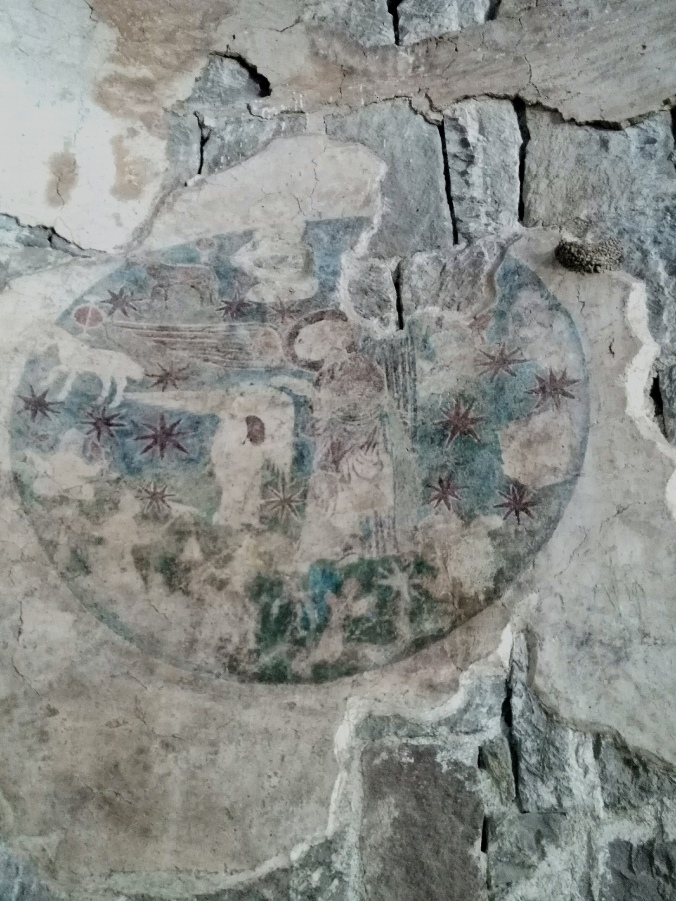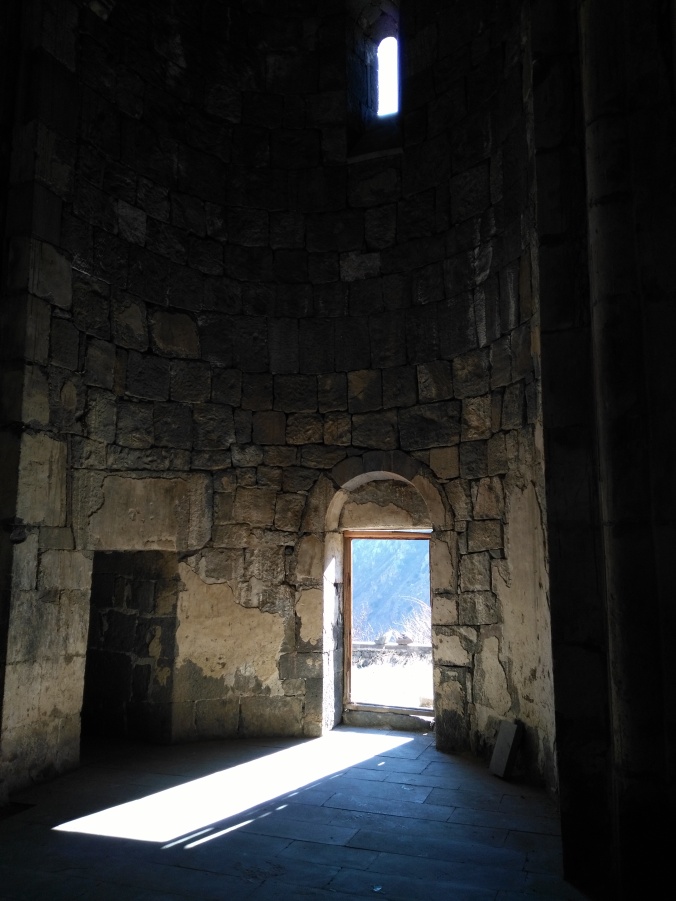I first found out about Vorotnavank (Որոտնավանք) when I googled my village during our site placement announcement. The sparse Wikipedia page didn’t have much information but it did mention this nearby monastery. Further research into the structure didn’t reveal much else.

I finally got the opportunity to visit it months later when I moved down here. I climbed to the top of a small hill where the WWII monument overlooks the cemetery and the rest of Vaghatin. From there I saw a path through the brush, likely made by grazing cattle, that ran steeply down the hill. At the end of it was the main stretch of road (the only one with asphalt south of Sisian) and Vorotnavank.

Vaghatin’s World War II Memorial
Coming down was more precarious than I thought, especially since I was wearing Vans and not hiking boots. Once I made it to the road, the rest of the walk was far easier. Since cattle and sheep use this road more than cars, it’s still in great condition.
I finally rounded the hill blocking the monastery from view and was met with a strong breeze. Perched at the top of a gorge, winds never cease. From here I can see the Vorotan River, a small power plant, a fish hatchery and a few residences sprinkled through the gorge. It’s incredibly beautiful to be able to take in such a vast landscape. Each season will doubtless paint this place in such a picturesque way. While autumn is reputed to be the most charming season in Syunik province, I’m excited to see how a blanket of snow will dress this view.

Vorotan Gorge
I rounded the campus of the monastery before entering. Along the west side is a small cemetery with about 20 khachkars (“cross stones” in Armenian). These intricate pieces of stone masonry are one of the more notable things about Armenian culture and religion. While these thoroughly embellished pieces are mostly arrayed with crosses, they also include images of pomegranates, horses, and men dressed for battle. The khachkars that display dates were placed here in the 1920s and 1930s. Others, however, seem much older judging by the way they are worn down from the constant exposure to the elements. The area which hosts most of the khachkars is overgrown now but still watching over the Vorotan River below.
Eventually, I stepped inside the first of two churches which make up the monastery. Despite the constant howling winds beating against the walls, inside silence was all encompassing. I entered a long dark hall adorned with even more khackars on the northern and southern walls. Light and occasionally magpies came in through the two small entrances. On one end of the hall I found a perfectly circular pit carved into the foundation that was about four feet in diameter. The dirt floor, eight feet below me, was littered with trash and led deeper beneath Vorotnavank. This might have been the secret tunnel used by the residents in the event of a siege. According to some people in my village, it leads to a fortress called Vorotnabred. I decided not to start my spelunking career right then since a large amount of snakes are rumored to live nearby and I might have been unable to climb out once I was inside.
As I was leaving the hallway, I could hear the movement in the next room. I was already apprehensive entering this place, it was dark and abandoned after all. Hearing these small noises, I thought someone else was here. Part of me entertained the idea that it was some sort of ancient spirit whose duty was to drive all visitors away. I asked “Barev?” in the most masculine voice I could muster, only to be met with quiet. I crept slowly through the doorway only to be met with a massive but empty chapel. I turned right and found a table with small yellow candles that seemed to have been recently placed there. While many were blown out, some were still crackling. The church was so silent that this small noise traveled throughout the chamber and into the hallway. Votive candles are lit and prayed over in Armenian Apostolic churches all over. This church was not as abandoned as I initially thought.

This church is better known as the Surb Stepanos Nakhavka Church. It was commissioned to be built in 1000 AD by Queen Shahandukht of the Syunik Kingdom. When it was still operating, members of the congregation believed this place had the power to heal the most venomous snake bites. Rather than attempt to describe it, I’ll just post some pictures. Near the alter, Armenian visitors have left flowers, crucifixes, drawings and even miniature handmade models of Vorotnavank.

After spending some time in Surb Stepanos I left and walked through the adjacent archway leading to Surb Karapet. This second church was commissioned by Prince Sevada, Shahandukt’s son, about seven years after Surb Stepanos was completed. While it’s walls were once covered with frescos, the only one that remains is this one just above one of the sacristies.

Surb Karapet was mostly destroyed due to an earthquake that took place in the 1930’s. Thankfully over the course of decades, money and time has been donated to the restoration of the church. Unfortunately, many khackars were heavily damaged and to this day lay broken next to the cemetery.
As I left Surb Karapet through a different doorway, I came across a large pillar with more broken khackars stacked against it. It reminded me of a larger pillar I saw at Tatev earlier this summer (Armenia’s most famous monastery). Upon further research, I found that these pillars signify the fact that Armenian royalty was coronated here.

I left the monastery, after spending some more time looking down at the Vorotan gorge, climbing back up to Vaghatin’s cemetery and passing some grazing cattle on the way. I still make the small hike to the monastery about every week. It’s so serene inside both churches, it shelters me from the winds outside and offers a calm place to reflect. Occasionally, I run into Armenian (and sometimes foreign) tourists taking in the sites and lighting some candles inside. More often than not, I have Vorotnavank to myself.








wow — this is a great narrative, Sam. Nice pics and wise choice to skip the tunneling.
LikeLike